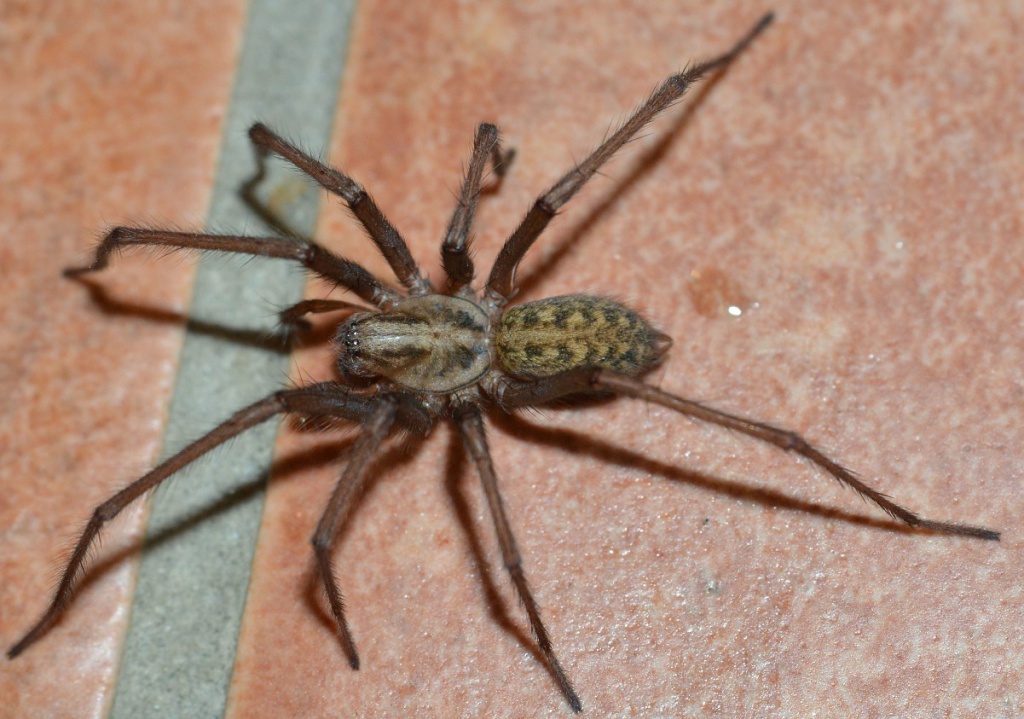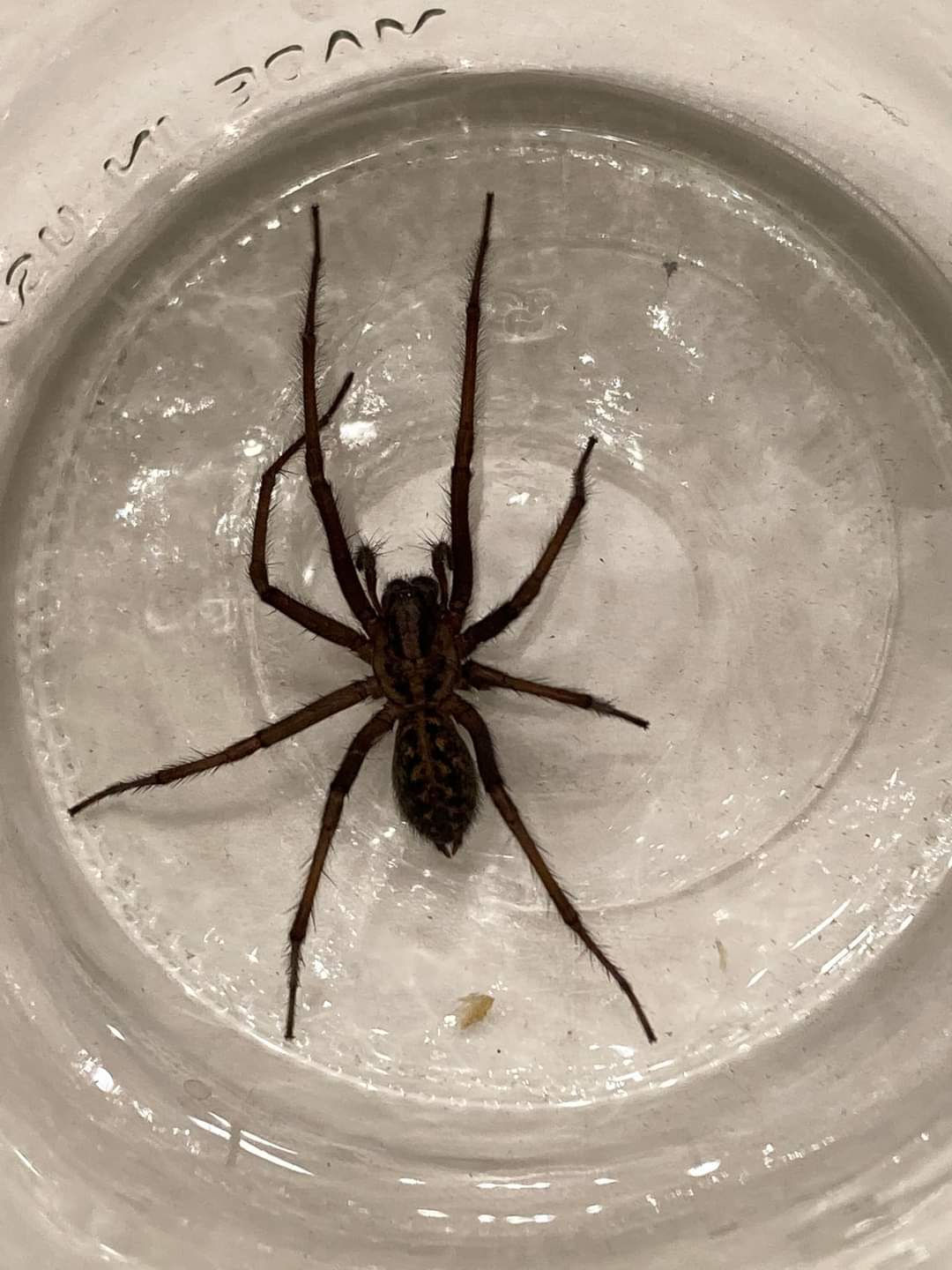
The giant house spider is one of our fastest invertebrates, running up to half a metre per second. This large, brown spider spins sheet-like cobwebs and pops up in the dark corners of houses, particularly in autumn.
Body length: up to 1.6cm
Leg span: up to 7.5cm
The giant house spider is the larger cousin of the House spider (Tegenaria domestica), and can be found living behind the fireplace, under the sofa, or in the bath. Giant house spiders are particularly prevalent in the autumn when the males are out looking for females. The males stay with their chosen females for some weeks, mating numerous times until eventually they die, at which point they are eaten by their female. Giant house spiders spin sheet-like cobwebs in neglected corners of the room and wait close by for unsuspecting insects to get caught; they are most active at night.
How to identify
The giant house spider is one of several very similar species of house spider. As a group, their long-legs, dark hairy bodies and preference for houses and buildings make them unmistakeable.
Did you know?
Female house spiders can live for several years, and both males and females can survive for months without eating or drinking.

Females can reach 18 mm in length, with males having a slightly smaller body at around 12 mm to 15 mm in length. The female leg span is typically around 45 mm. The leg span of the male is highly variable, with spans between 25 mm to 75 mm being common. The former genus Tegenaria has recently been split: Tegenaria spp. have banded legs, Eratigena spp. have plain legs. Beyond this distinction, species can only be identified (with difficulty) by examination of the genitals of mature specimens.
Giant House Spiders Identification
What Do Giant House Spiders Look Like?
Giant house spiders are a very common spider species found in North Carolina. They have a leg span that can reach up to 4 inches, with a brown and hairy body. Their abdomen is patterned with a series of marks, usually lighter than their overall body color. Their large size and speed are notable characteristics.
How big are Giant House Spiders?
Giant House Spiders can reach a leg span of up to 4 inches (10 cm), with their body length averaging between 0.6 to 0.7 inches (15 to 18 mm). Among the largest spider species commonly found in houses, Giant House Spiders are known for their fast speed and large size. Despite their intimidating appearance, they are generally harmless to humans and often contribute to controlling pests in homes by preying on insects.

Signs of a Giant House Spider Infestation
The giant house spider can be found in dark corners of rooms, storage sheds, barns, bridges, fences, and other structures. This large spider generally constructs funnel webs on window angles and in corners. Although giant house spiders prefer to live outdoors, they are hitchhikers and can be brought indoors when they hide in boxes, firewood, or other belongings.
Habitat, Diet, Life Cycle & Bites
Where Do Giant House Spiders Live?
Giant house spiders are most often spotted indoors during the autumn when they have reached their maximum size. They prefer dark and quiet areas and are commonly found in houses, specifically in garages, basements, and attics. Outdoors, they reside in sheds, under rocks, and in woodpiles.
Diet of a Giant House Spider
Their diet mainly consists of insects, which they capture in their large, sheet-like webs. They play a significant role in controlling pests within the household.
Life Cycle of a Giant House Spider
The life cycle of giant house spiders includes the egg, spiderling, and adult stages. Females lay eggs in silken sacs, often hidden within their web. Spiderlings emerge and go through several molts before reaching maturity.
Can a Giant House Spider Bite?
Yes, a giant house spider can bite, but it is rare and usually occurs only when the spider feels threatened or is accidentally disturbed. Giant house spiders are not aggressive and usually run away, very rapidly, when startled. Giant House Spider bites are not serious and the giant house spiders’ venom is only harmful to individuals with specific allergies.
Are Giant House Spiders Poisonous?
No, giant house spiders are not poisonous to humans. Their venom is used for hunting their prey and is not harmful to humans. They are often feared due to their size, but giant house spider venom is not potent enough to cause significant harm to humans.Even if bitten, the effects are typically mild, and understanding this can help alleviate common fears about these large, but essentially harmless, spiders.
How to Get Rid of Giant House Spiders?
Eliminating giant house spiders involves keeping homes clean and clutter-free, especially in areas where they are likely to build webs. Regular vacuuming and dusting can help to remove spiders and their webs. For persistent spiders, contact our professional spider removal team to assist.
Giant House Spider Prevention Tips
To prevent giant house spiders, seal cracks and gaps in the home’s exterior to prevent entry. Reduce outdoor lighting that attracts insects, which in turn can attract spiders.
